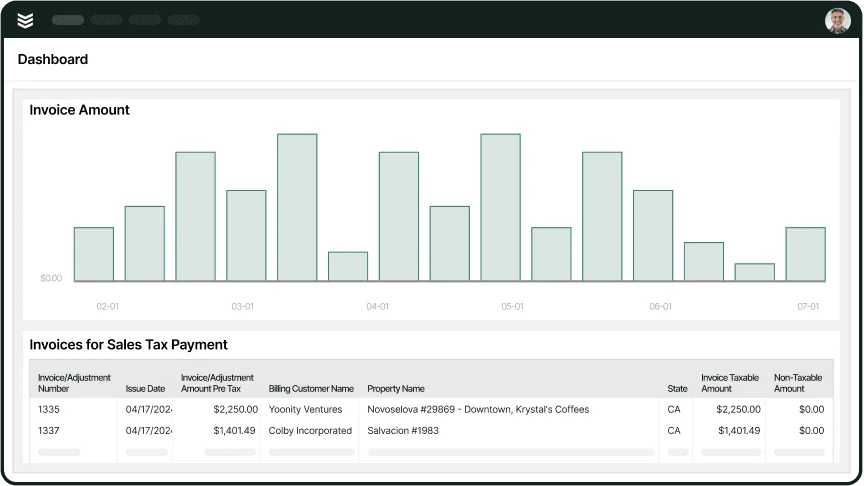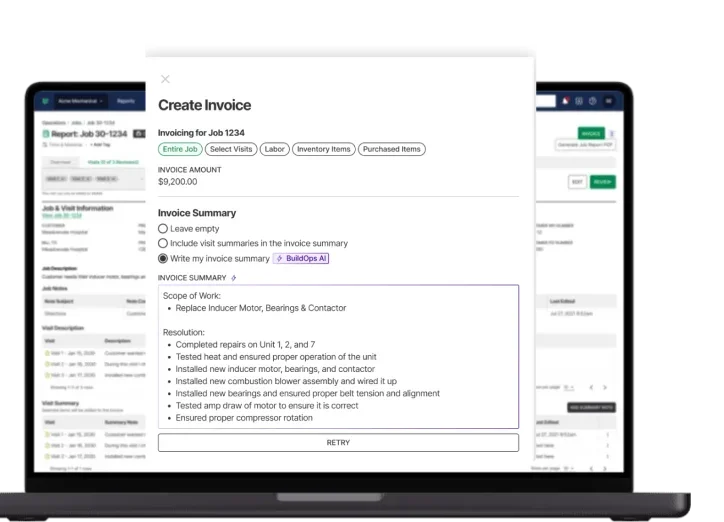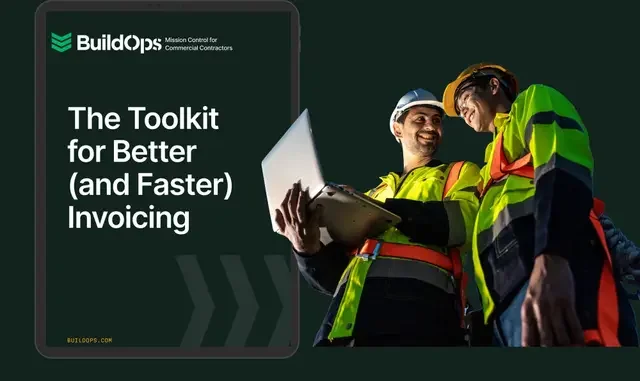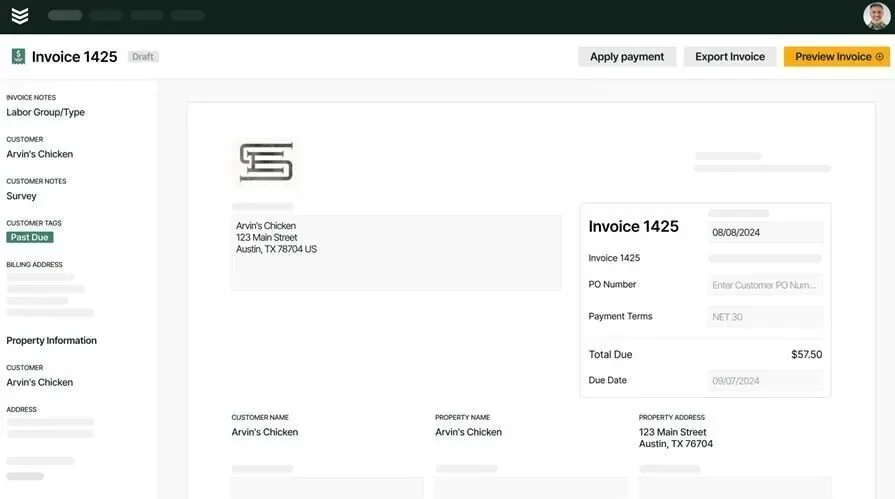Keeping up with jobs is already a challenge for electrical contractors. But invoicing? That’s where things can really slow down. Late payments, missing details, and paperwork piling up—it’s a mess that cuts into your cash flow. Electrical service businesses need a solution built for the field, not the back office. That’s where an electrical invoice app comes in.
With the right invoicing tool, your techs can generate invoices on-site, capture signatures instantly, and send out bills before they even leave the job. No more lost paperwork or waiting until the end of the week to track down payments. The right app should complement your team's workflow seamlessly. In this guide, we’ll cover the following:
- Choosing the right electrical invoice app for your techs
- 6 key features to look for in an electrician invoice app
- Types of invoicing apps for electricians
- 5 best plumbing invoice apps for your technicians
- 7 benefits of using a plumbing invoice app
- 4 important plumber invoice app FAQs answered
Before picking an invoicing app, electrical contractors need to ask the right questions. Can your techs use it from the field? Does it integrate with your existing tools? Will it actually speed up payments? Let’s break down what to look for when choosing an electrical invoice app for your team.
Choosing the right electrical invoice app for your techs
Electrical contractors don’t have time for clunky software that slows them down. Your invoice app should speed up payments, not create extra steps. The right tool should fit the way your team works—whether they’re on-site or in the office. Before committing to an invoicing app, here’s what to consider to make sure it actually helps your business.
- Ease of use — Will your techs pick it up quickly, or will they need constant training? Can they send invoices straight from the job site without hassle?
- Integration with existing tools — Does it connect with your accounting software? Can it pull job details automatically, or will you be stuck re-entering information?
- Payment processing — Can customers pay on the spot? Does it support credit cards, ACH transfers, or financing options?
- Customization options — Can you add your company’s branding, adjust invoice layouts, and set custom payment terms?
- Features — Beyond invoicing, does it offer scheduling, job tracking, or automated reminders to follow up on unpaid invoices?
A good invoice app should do more than just send bills—it should simplify your entire payment process. Now, let’s break down the six key features that make an invoicing app a real asset for your electrical business.
6 key features to look for in an electrician invoice app
Invoicing shouldn’t slow down the job—it should be as seamless as flipping a switch. For electrical contractors, every minute spent chasing payments or fixing billing mistakes is time taken away from actual work. A strong electrician invoice app ensures that as soon as a job is wrapped up, the invoice is sent, the payment is processed, and the books stay balanced. But not all invoice apps are built for the way electricians work. The right one fits into your workflow, not the other way around. Here’s what to look for to keep your operation running efficiently.
1. Mobile accessibility for on-the-go invoicing
Here’s an example of an everyday scenario: A service call is wrapping up, and the tech has one last step before heading to the next job—sending the invoice. Instead of calling the office or scribbling down notes to deal with later, he pulls out his phone, selects the completed tasks, and hits send. The invoice lands in the customer’s inbox before the truck leaves the driveway. This kind of efficiency is only possible with an invoice app built for mobile use. A mobile-friendly app keeps paperwork from piling up and ensures jobs get closed out on the spot.
2. Integrated scheduling and dispatching
Imagine a dispatcher assigns a last-minute service request to a nearby tech. After the repair is done, the job details automatically sync to an invoice, ready to send with no extra steps. There’s no risk of forgetting to bill for labor or materials—everything is accounted for. By linking invoicing with scheduling, electrical businesses can avoid missed revenue and keep cash flow steady. An invoice app with scheduling integration eliminates double entry and streamlines job-to-payment workflows.
3. Automated payment processing
Take an electrician who finished installing a new panel for a commercial client. Instead of waiting weeks for a check, he hands over a tablet, and the customer pays instantly with a credit card. Funds are on their way before the tech even packs up. The right invoice app should support multiple payment options, reducing the risk of unpaid invoices and speeding up cash flow. An invoice app with built-in payment processing helps electrical contractors get paid faster and with less hassle.
4. Custom quotes that convert to invoices
Say an electrical contractor sends an estimate for a lighting retrofit. A few days later, the client approves the quote, and with a single click, it converts into an invoice—no extra paperwork, no duplicate data entry. This smooth transition from proposal to payment speeds up the process and reduces billing errors. An invoice app with seamless quoting makes it easier to go from bidding on a job to getting paid for it.
5. GPS and fleet tracking for accurate billing
For instance, a tech spends the day driving between multiple job sites. By the end of the shift, instead of guessing mileage for reimbursement, his invoice app has already tracked the distances traveled and added them to the final bill. Whether it’s fuel costs or travel time, every expense is accounted for. An invoice app with fleet tracking ensures that electrical businesses don’t leave money on the table when it comes to billable miles.
6. Detailed reporting for smarter financial decisions
For example, at the end of the month, an electrical business owner pulls up invoicing reports and spots a pattern—certain jobs consistently take longer than estimated, eating into profits. With this insight, they adjust labor rates and improve scheduling to prevent underpricing. Good reporting turns data into action, helping contractors fine-tune their pricing and operations. An invoice app with robust reporting tools gives electrical professionals the numbers they need to make informed business decisions.

Explore our Invoicing product
Find out how BuildOps can streamline invoicing so you’re always paid promptly.
Other notable features for electrical invoice apps
Beyond the core essentials, a solid electrical invoice app should come with additional features that help streamline operations, reduce manual work, and improve accuracy. These extra tools don’t just make invoicing easier—they create a more connected workflow that saves time and eliminates errors.
- Automated service agreements: Managing recurring maintenance contracts manually can lead to missed services and delayed billing. An invoicing app that supports automated service agreements ensures that scheduled work is tracked, invoiced, and renewed without extra admin work. Invoice apps with service agreement automation help electrical contractors maintain steady revenue with minimal effort.
- Time tracking for accurate labor costs: Managing recurring maintenance contracts manually can lead to missed services and delayed billing. An invoicing app that supports automated service agreements ensures that scheduled work is tracked, invoiced, and renewed without extra admin work. Invoice apps with service agreement automation help electrical contractors maintain steady revenue with minimal effort.
- CRM integration for better client management: Keeping track of customer history, past invoices, and job details in separate systems leads to confusion and inefficiency. A construction CRM that connects invoicing with customer records keeps everything in one place, making it easier to manage repeat clients and send follow-ups. Invoice apps with CRM integration give electrical businesses a full picture of their customer interactions.
A well-rounded invoice app does more than just send bills—it helps electrical contractors work smarter, reduce admin burdens, and keep their business running efficiently.
Types of invoicing apps for electricians
Not all invoicing apps work the same way. Some are built for larger electrical companies managing multiple crews, while others cater to solo electricians handling their own billing. The best choice depends on the size of your operation, the complexity of your jobs, and how you prefer to handle payments. Here’s a breakdown of the main types of electrician invoice apps and what they offer.
- Cloud-based invoice apps: These apps store data online, allowing contractors to access invoices, customer records, and payment history from any device. They’re ideal for electrical businesses with multiple employees or those who need remote access. Cloud-based systems also make it easier to integrate with other software like scheduling and CRM tools.
- On-premise invoicing software: Some companies prefer to keep their invoicing system in-house rather than relying on cloud storage. On-premise solutions offer greater control over data security but require regular maintenance and updates. These are best suited for larger electrical firms with dedicated IT teams.
- Mobile-first invoice apps: Designed for field techs, these apps prioritize mobile functionality, letting electricians generate and send invoices directly from their phones or tablets. This type is perfect for contractors who spend most of their time on job sites and need a quick, efficient way to bill customers on the go.
- Integrated invoicing platforms: Some invoicing apps come as part of a larger business management system, combining invoicing with scheduling, dispatching, and CRM features. These all-in-one solutions streamline operations and reduce the need for multiple software tools, making them a great fit for growing electrical businesses.
- Freemium and budget-friendly invoicing apps: For independent electricians or small teams, free or low-cost invoicing apps provide essential billing functions without the overhead of a full-featured system. While they may lack advanced features, they’re a good starting point for those looking to digitize their invoicing without a big investment.
Whether you need a mobile-first solution, a cloud-based system, or an all-in-one platform—the right invoicing app depends on how your electrical business operates. But no matter the type, the best apps have one thing in common: they make invoicing fast, accurate, and hassle-free. Now, let’s take a look at some of the best invoice apps for electrical contractors and what makes them stand out.
5 best invoice apps for electrical contractors
Finding the right invoicing solution is crucial for keeping jobs on track and payments coming in without delays. The best apps do more than just generate invoices—they integrate with scheduling, automate payments, and keep financial records organized. Here’s a look at the top invoice apps for electrical contractors, categorized by business type.
1. Best for commercial contractors: BuildOps
BuildOps is designed specifically for commercial electrical contractors, offering an all-in-one solution that connects invoicing, job tracking, and customer management. Unlike generic invoicing apps, BuildOps is tailored for complex commercial projects, helping businesses manage large-scale jobs, track multiple service locations, and automate billing workflows.
App Type: Cloud-based & Web-based solution
How Pricing Works: We provide weekly live demos and the opportunity to schedule a customized session where we help you explore features and select the best option for the needs of your small business.
Features Beyond Invoicing: Includes advanced job scheduling, service agreements, asset tracking, and technician management to streamline commercial electrical operations.
What Sets It Apart for Commercial: BuildOps integrates every aspect of a commercial electrical business, from dispatching to invoicing, ensuring nothing falls through the cracks.

Check out BuildOps Invoicing App
Learn how BuildOps can help electrical contractors streamline invoicing.
2. Best for residential contractors: HouseCall Pro
Image Source: Housecall Pro
HouseCall Pro is built for residential electricians who need an easy-to-use invoicing app that integrates with customer communication and payment processing. It offers simple job tracking, online booking, and automation features that help small electrical businesses manage their daily operations. However, it may not be the best fit for large commercial contractors, as it lacks the advanced project management tools needed for multi-location and enterprise-level jobs.
App Type: Cloud-based solution, Web-based solution
How Pricing Works: Subscription-based pricing starts at $65/month for small businesses, with additional features available in higher tiers.
Features Beyond Invoicing: Includes online booking, automated customer reminders, and mobile payment processing to improve service efficiency.
What Sets It Apart for Residential: Designed for fast-paced residential service businesses, HouseCall Pro simplifies invoicing and scheduling while keeping customer interactions smooth.
3. Best for general contractors: Jobber
Image Source: Jobber
Jobber is a versatile invoicing and business management solution used by electricians, plumbers, and HVAC contractors. It’s ideal for electrical businesses that handle a mix of residential and small commercial projects, offering features like job scheduling, estimates, and automated follow-ups. Despite that, it may not be ideal for large electrical firms handling complex, multi-phase projects, as it lacks deeper enterprise-level integrations.
App Type: Cloud-based solution, Web-based solution
How Pricing Works: Monthly team plans start at $129, with premium options for larger teams.
Features Beyond Invoicing: Provides client reminders, estimate approvals, and job tracking in one platform.
What Sets It Apart for General Contractors: Jobber’s mix of scheduling, invoicing, and CRM tools makes it a great choice for electricians managing various job types.
4. Best for small to mid-sized plumbing businesses: Joist
Image Source: Joist
Joist is a budget-friendly invoicing app aimed at smaller electrical businesses that need a simple way to create estimates, send invoices, and process payments. While it’s a great entry-level tool, it may not be the best choice for scaling businesses, as it lacks robust automation, integrations, and advanced job tracking features.
App Type: Mobile app, Web-based solution
How Pricing Works: Offers a free version with basic invoicing tools, while premium plans start at $8/month.
Features Beyond Invoicing: Includes estimate templates, payment tracking, and QuickBooks integration for basic accounting.
What Sets It Apart for Small to Mid-Sized Electrical Businesses: Joist is a lightweight, easy-to-use invoicing tool that helps small electrical businesses stay organized without high costs.
5. Best for scaling businesses: FieldPulse
Image Source: FieldPulse
FieldPulse is a feature-rich field service management tool that includes invoicing, scheduling, and customer management, making it a solid choice for electrical contractors looking to scale. Although, its broad range of features may feel overwhelming for smaller businesses that only need a simple invoicing tool without additional project management capabilities.
App Type: Cloud-based solution, Web-based solution
How Pricing Works: Pricing details are available by request. Prices vary based on team size and the specific features required.
Features Beyond Invoicing: Offers team tracking, job costing, and proposal management to help businesses expand efficiently.
What Sets It Apart for Scaling Businesses: FieldPulse is designed for electrical contractors who want an all-in-one platform to manage their growing operations without juggling multiple apps.
7 benefits of using an invoice app for electrical contractors
For electrical contractors, staying on top of invoicing is just as important as completing the job itself. Late payments, lost paperwork, and manual data entry eat into profits and create unnecessary stress. A well-designed electrician invoice app removes these roadblocks, helping businesses get paid faster, reduce admin work, and improve financial tracking. Here’s how the right tool can make a real difference.
1. Faster payments and improved cash flow
Waiting weeks or months for payment can cripple an electrical business. An invoice app speeds up the process by allowing customers to pay instantly via credit card, ACH transfer, or financing options. With automated payment reminders, contractors spend less time chasing down unpaid invoices and more time growing their business. Electrical contractors using scheduling apps can further streamline job completion to invoicing, ensuring a smooth payment cycle.
Deep Dive
The gap between fast and slow invoicing is bigger than most think. According to our breakdown of the Invoicing Sweet Spot, contractors who wait more than five days to invoice are 56% less likely to get paid on time compared to those who invoice within 24 hours. To compound this, we found that 40% of contractors who rely on disconnected systems or manual processes take more than a week to send an invoice.
That delay slows cash flow. Because of this, it’s crucial to choose an invoicing app that empowers your team to streamline operations, automate processes, and improve productivity.
2. Reduced errors and lost invoices
Paper invoices can get misplaced, and manual entry mistakes can lead to underbilling or missed charges. A digital invoicing system ensures accuracy by automatically pulling job details, labor hours, and materials used—eliminating costly errors and making audits easier. Electrical contractors using advanced CRMs benefit from an even more seamless workflow, keeping every invoice linked to the right customer and project.
3. Better organization and record-keeping
Keeping track of past invoices, payment histories, and outstanding balances is critical for electrical contractors. An invoicing app stores everything in one place, making it easy to pull up past transactions, generate reports, and track financial performance without sorting through stacks of paper or spreadsheets.
4. More time for actual electrical work
Every minute spent on invoicing is a minute not spent on the job site. A good invoice app automates repetitive tasks like sending payment reminders, generating recurring invoices, and logging payments—freeing up valuable time for contractors to focus on their trade instead of admin work.
5. Professionalism that builds customer trust
A well-structured, branded digital invoice makes a stronger impression than a handwritten or generic template. Automated invoices with clear breakdowns of labor and materials show customers exactly what they’re paying for, reducing disputes and improving trust. This level of professionalism can lead to repeat business and referrals.
6. Improved communication between office and field
A major challenge for electrical businesses is the disconnect between office staff and field techs. With an integrated invoicing system, techs can generate invoices from the job site while the office monitors payments and financial reports in real-time. Our customer’s success stories like Advanced Electrical highlight how better communication leads to efficiency and fewer missed payments.
7. Easier scaling for growing businesses
As an electrical business grows, handling more jobs means more invoices to track. A scalable invoice app grows with the company, allowing contractors to manage increasing workloads without added complexity. Companies like RBT Electrical have seen firsthand how the right invoicing system supports expansion without overwhelming the back office.
A powerful invoice app does more than just send bills—it improves efficiency, speeds up payments, and keeps operations running smoothly. Electrical contractors looking to eliminate invoicing headaches and boost cash flow should explore how the right software can transform their business.

Learn how to optimize the invoicing process
Don’t just leave invoicing on autopilot — use our handy guide to maximize impact.
4 important electrical invoice app FAQs answered
Electrical contractors often have questions when switching from traditional invoicing methods to a digital solution. Whether it’s about functionality, cost, or best practices, understanding how an electrical invoice app works can help businesses make the right decision. Here are answers to some of the most common questions.
1. What is an electrical invoice app?
An electrical invoice app is a digital tool designed to help electrical contractors create, send, track, and manage invoices efficiently. It automates billing, reduces paperwork, and integrates with scheduling, payments, and customer management systems to streamline your financial operations.
With features like mobile accessibility, automated reminders, and real-time tracking, these apps ensure electricians get paid faster and minimize administrative tasks. Many also integrate with CRM systems and scheduling apps to keep invoicing connected to job management.
2. How do electrician invoice apps work?
Electrical invoice apps simplify the billing process by:
- Allowing techs to generate invoices directly from the field
- Syncing with scheduling tools to pull job details automatically
- Offering multiple payment options, including credit card and ACH
- Sending automated reminders for overdue payments
- Tracking invoice statuses in real-time to avoid missed payments
By integrating with field service software, these apps help electricians manage everything from job completion to final payment in one platform.
3. Is the cost of an invoice app worth it for electrical contractors?
Yes—an invoice app quickly pays for itself by reducing unpaid invoices, eliminating manual data entry errors, and speeding up the payment cycle. Instead of wasting time on paperwork or chasing down clients, electrical contractors can focus on getting more jobs done. Many apps also prevent revenue loss by ensuring all labor and materials are properly accounted for on invoices.
For businesses looking to scale, the investment in an invoice app becomes even more valuable, as it allows them to manage higher volumes of work without increasing administrative workload.
4. What are some best practices to follow when implementing an electrical invoice app?
To get the most out of an invoicing app, electrical contractors should follow these key steps:
- Choose an app with industry-specific features – Generic invoicing tools may lack the integrations and functionality needed for electrical businesses
- Train your team – Ensure both office staff and field techs know how to create, send, and track invoices efficiently
- Integrate with scheduling and CRM tools – Keep job details connected to invoicing for a smoother workflow
- Set up automated payment reminders – Reduce late payments by having the system follow up automatically
- Use mobile invoicing – Allow techs to generate invoices immediately after completing a job to avoid delays
- Offer multiple payment options – Make it easy for customers to pay by accepting credit cards, ACH, or financing
- Monitor reports and analytics – Track trends in payments, outstanding invoices, and revenue to improve financial planning
- Keep branding consistent – Customize invoices with your company logo and details to maintain a professional appearance
- Regularly update pricing and templates – Ensure invoices reflect current labor rates and material costs
- Test and optimize – Get feedback from your team on what works best and make adjustments as needed
The right electrical invoice app does more than just send bills—it streamlines operations, reduces admin work, and ensures contractors get paid on time. From mobile invoicing to automated payment processing and real-time reporting, the features covered here help electrical businesses stay efficient and profitable. However, not all invoicing apps offer these tools in a single platform, leaving contractors juggling multiple solutions.
For commercial electrical contractors who need an all-in-one platform that connects invoicing, scheduling, dispatching, and customer management, BuildOps brings it all together. While many tools focus solely on invoicing, BuildOps is built for the demands of large-scale electrical businesses—helping teams track jobs, manage payments, and keep projects moving without missing a beat.

Want to see how it works in action?
Explore how BuildOps simplifies invoicing and financial management for electricians.







